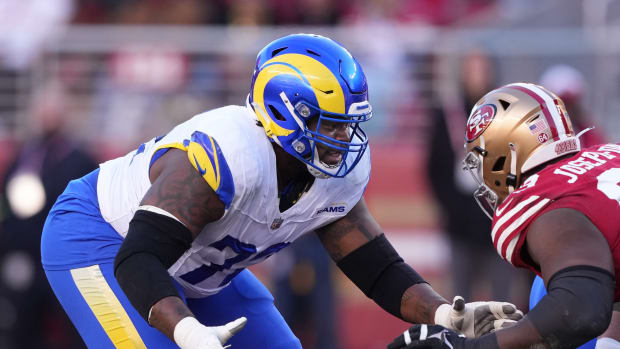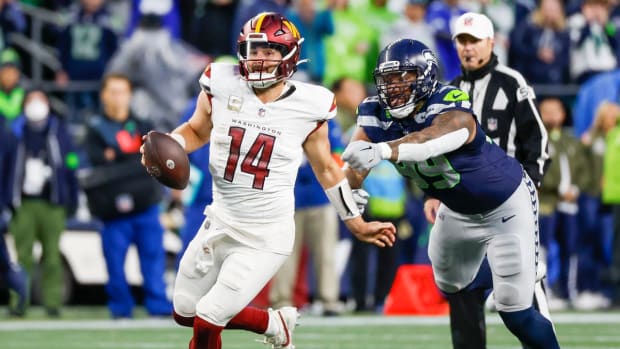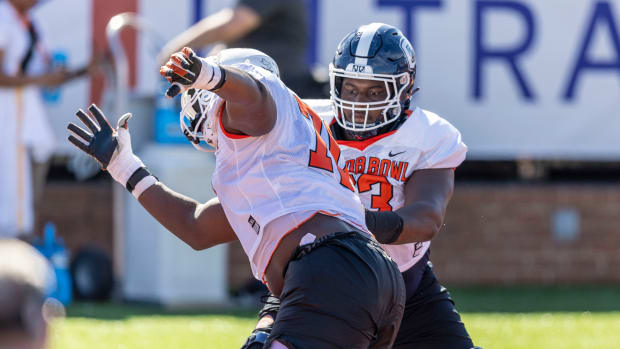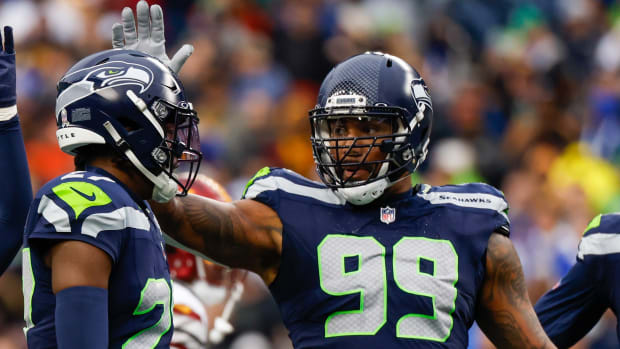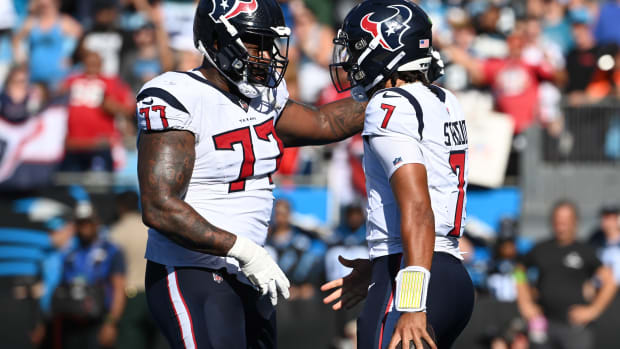Film Breakdown: Seahawks Must Hope Raw, Talented Stephen Sullivan Clears Waivers
Nobody needed the preseason more than Stephen Sullivan. The Seahawks tight end, taken in the seventh round of the 2020 NFL Draft, was described as “a project” by general manager John Schneider.
Exhibition football would have likely resulted in the 23-year old Sullivan becoming a preseason darling on a level similar to that of the Kasen Williams heartthrob. Like Williams, Sullivan would have been able to flash pass catching ability that would have led to some dominant performances against lower string talent.
However, with the global pandemic of COVID-19 severely impacting the NFL offseason program, we’ve barely seen Sullivan play. Preseason games have been cancelled, scrimmages have happened behind closed doors, and camp has been shortened. What’s super necessary for rookie pass catchers is to be able to show off their most obvious talent. Yet it must have been so much tougher for guys like Sullivan to establish the necessary chemistry with a quarterback in order for this to flourish.
The only tape we have of him is pre-Seattle. What’s immediately clear before film-grinding is the Seahawks wanted Sullivan badly, trading a 2021 sixth round pick to the Dolphins for the 251st selection to draft him.
Having played wide receiver at LSU, Sullivan got moved to tight end in his senior year on the Tigers. However, he barely played in the magical National Championship-winning season. Instead, Thaddeus Moss got most of the action in the 11 personnel-heavy attack.
“The first thing that Coach O would say about him is that they just, with all of the talent that they had, they didn’t use him [Sullivan] enough,” Pete Carroll declared in the draft conclusion press conference. “And they [LSU] weren’t able to get him in enough and they kinda kicked themselves, they wished they would have been able to.”
Moss, though, went undrafted. Sullivan’s profile, meanwhile, was enough for him to be picked right before the draft concluded. It was this moment that, if you move your mind back to April, sparked the best draft day call in the history of the event, a truly wholesome moment that, if it fails to make you smile, reveals you to be truly a miserable bastard: “Don’t play with me coach!”
The receiver tape of 2017 and 2018 gets you thinking “You look kinda slow for a wideout (you look kinda short for a storm trooper)," with Sullivan more of a long strider while lacking upper speed and gears. This showed when running certain routes. Sullivan lacked the genuine speed threat required to be successful against defensive backs on certain plays. He also struggled to separate on particular routes.
At 6-foot-5 with 35 3/8-inch arms (98th percentile for tight ends), the target radius is obvious though. Combined with his concentration when tracking the football, Sullivan is one heck of a pass catcher. The ability to powerfully high-point the football only makes him more deadly: at 248 pounds, he jumped 123 inches (91st percentile) in the broad and 36 1/2 inches (86th percentile) vertically. Check out these catches away from his frame where feel for the coverage got him in the spot.
Sulllivan at wide receiver wasn’t the quickest or more agile of separators when dealing with press coverage, instead opting for violence and a box out approach. There was a noticeable improvement in his savvy at dealing with press releases in 2019, with new line of scrimmage plans showing up.
Carroll praised him in this area, predicting future success after Seattle had drafted Sullivan: “His release ability as well, and getting off the line of scrimmage, he’s going to be really good at that in short time.”
LSU’s decision to put Sullivan at tight end meant that he still got some opportunities as a big slot and as an isolated x receiver. It prevented him, however, from having to go up against outside corners and run routes which required agility.
Balance issues mainly showed up when trying to run slants from the outside. Stumbling and body control issues can be seen in the cut-up below. Sullivan’s testing also reflects this: he ran a 7.51 second 3-cone drill (6th percentile) and a 4.62 second short shuttle (4th percentile).
Unsurprisingly, Sullivan’s cuts were round at times, particularly in earlier years, and still require refinement. Sharpening up his hand usage and head fakes would also benefit his ability to separate and come clean quicker.
Sullivan possessing a big frame would make him an obvious candidate to receiver possession-type throws such as goal line fade routes. Yet body contortion issues at the catch point were present. The play-type is inefficient, yet a more convincing double move and a better boxing out of defenders would also improve Sullivan’s success on the design.
In 2019, better route running from Sullivan was evident and he faced more suitable matchups for his player profile. He slowed when identifying holes in zone coverage. He improvised on scramble drills in ultra-Seahawk-y fashion. His cuts were more definite. His pass-catching ability remained obvious, where he could win control of the ball excellently.
After the catch, Sullivan was an absolute load to bring down. His focus on transitioning from receiver to runner made him reliable in this area. And, once carrying the football, defensive backs were forced to go low on his presence as would-be-tacklers bounced off him. Sullivan also showed high effort and leg drive in piles.
The last time Carroll mentioned Sullivan in detail to the media, at the time of publishing, was August 20.
“Steph has really done some good stuff for us,” Carroll praised. “We’ve been really excited about his work; he shows the catching skills that the wide receiver background brings, you know.” As expected, the standout traits are his ability to be an aerial weapon. He brings outside and inside experience, with a knowledge of how to run a variety of routes.
Seattle will want Sullivan to be able to block too. This is a huge part of their entire offensive approach, but it’s particularly true for Seahawks tight ends. When fitted up, Sullivan had driving block power and strength at the point of attack, even getting some pancakes in.
Things got less appealing when Sullivan was asked to be a stalk blocker. His leverage maintenance was poor, with him over-running defenders in space and taking poor angles that saw him whiff. Staying on the near hip and hunting his block with the right leverage would benefit him. The aiming points were poor.
Playing tight end, Sullivan is more likely to get inline blocks rather than stalk blocking. His blocking effort is there, as is the power from his long frame. The issue is his pad level getting too high when trying to drive defenders back in a combo block when attached to the offensive line. Additionally, Sullivan requires work when trying to seal inside moves.
“It is a project, for us, to teach him how to be on the line of scrimmage and what he can do there,” confessed Carroll on August 20. “He’s played there some, but not a lot, so that’s Pat McPherson’s job [Seahawks tight end coach] to try to figure out how to catch him up.”
The Seahawks aren’t afraid of asking their tight end to stay in to protect the quarterback, especially off play action. Although Sullivan did well at the Senior Bowl in the 1-on-1 pass pro drills versus linebackers and safeties, he struggled with this aspect in college games. Rather than kick sliding or jump setting, it appears Sullivan was taught a turning technique that lacked power and saw him get smashed back or inside moved; his feet require work. He did, though, stay tight to the protection when it was a play-fake slide.
Another hesitation with Sullivan is the blown assignments that existed on tape. Perhaps this was a by-product of not playing a major role in the offense, of being a substitute. Maybe it was coaching that left depth pieces behind. Whatever the explanation, Sullivan occasionally looked unsure of his role on the play and cost his team.
So, Sullivan’s transition from wide receiver to tight end is still ongoing. This is something the Seahawks were, of course, aware of when they took him. Schneider said after the draft: “He would be the one person of the group... that is a little bit more of a developmental prospect.”
There are plenty of aspects that Sullivan will have been working on and trying to pick up in the offseason. Based on the live stream footage that Seattle has released, he already seems to have improved his pad level when blocking in-line. On August 25, offensive coordinator Brian Schottenheimer told reporters that the legendary Greg Olsen had been helping Sullivan, with Schotty “watching [Olsen] get a chance to work with Sully.” Blocking must have been included in the guidance.
The best footage we have of Sullivan came at the Senior Bowl where he dominated in 1-on-1s. His 4.66 second 40 (76th percentile) looked quicker down in Mobile. The catching ability from college was present, but it was nice to see further elements too - for instance, Sullivan regularly stacked his defender once he had got in behind. This was the supreme performance he needed to announce himself.
“He had a great Senior Bowl playing tight end the whole time,” assessed Schneider in late April. “We were able to get great reports on him down there and spend some real quality time with him.”
Sullivan’s run blocking reps from the pre-draft All-Star game still suffered from his pad level rising.
“We have to develop his game,” was how Carroll summarized the project of coaching Sullivan four months ago. Necessary improvements aside: those hands, that concentration, that height will always draw you back in to loving this pick.
“He’s a really nice athlete and I really like the pick that we made, he looks like he fits,” Carroll said on August 20.
“This is one of my favourites,” revealed Carroll post-day three of the draft. “Because this is a guy, when you look at him, and you have to really project at what he’s gonna be like. And we were willing to do that and John, and his guys, were willing to look at this guy’s potential, a guy that we could create maybe a real kind of role for.”
How badly did Carroll want Sullivan? “I think Pete told him at the combine that he was gonna make him a Seahawk,” shared Schneider. The last ‘Pete Carroll' day three pick was Chris Carson and that’s turned out pretty great.
Sullivan is, by all accounts, a great character and worth a seventh round flyer.
After the draft, Sullivan’s incredible story off the field and intangibles were talked about - naturally. He grew up in extreme poverty, experiencing homelessness and severe challenges.
“I kind of became a man on my own just from learning and watching,” he said in his first Seattle media appearance. “Watching coaches, watching family and things like that... It’s just so much that I’ve been through."
“We had a lot of buy in from a lot of people,” Schneider described, even sharing that Seattle almost talk Sullivan over Freddie Swain with their sixth round pick. “You know when you hear these stories, it definitely affects you...and look, he’s one of those guys you just wouldn’t bet against.”
“I got connected really through Coach O, as we talked about his guys and this story, and he lit up about this kid," Carroll disclosed on April 25. “And so I had a special eye on him throughout the time and was hoping that we could figure out a way.”
“Ed told me he’s going to be one of my favorite guys,” Carroll went on. “It’s surely is gonna be on us, because he’s gonna do his part.”
“He has got so much energy for it and such a great motor, really good guy to bring to the program.”
This brings us back to making the initial, "final" roster.
Sullivan has been competing in a loaded tight end room along with six other names - Greg Olsen, Will Dissly, Jacob Hollister, Luke Willson, Colby Parkinson, and Tyler Mabry. Carroll described Sullivan as needing to “balance” certain parts of his game out prior to camp. Since that point, Sullivan has also missed a fair chunk of training camp through injury. Based off all this information, Sullivan’s chances of making the ‘final 55’ looked slim and he was waived on Saturday morning.
Waived because he wasn’t able to develop enough in the bizarre circumstances of the COVID-19 offseason, Seahawks fans have to hope the high-upside talent lands back on Seattle's practice squad.
Encouragingly, the league expanded practice squad limits from 10 players to 16 in 2020. Russell Wilson loves, and needs, big-bodied targets and Sullivan could be that - even if his whole game isn’t quite ready right now. This project could still be a lot of fun. The Seahawks will be sweating waivers out.
